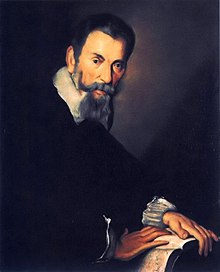Selva morale e spirituale
| Selva morale e spirituale | |
|---|---|
| Collection of sacred music by Claudio Monteverdi | |

The composer, portrayed in 1640 by Bernardo Strozzi
|
|
| Catalogue | SV 252–288 |
| Language |
|
| Published | 1640: Venice |
Selva morale e spirituale (SV 252–288) is the short title of a collection of sacred music by the Italian composer Claudio Monteverdi, published in Venice in 1640 and 1641. The title translates to "Moral and Spiritual Forest". The full title is: "Selva / Morale e Spirituale / di Clavdio Monteverde / Maestro di Capella della Serenissima / Republica Di Venetia / Dedicata / alla Sacra Cesarea Maesta dell’ Imperatrice / Eleonora / Gonzaga / Con Licenza de Superiori & Priuilegio. / In Venetia M DC X X X X / Appresso Bartolomeo Magni".
Selva morale e spirituale is regarded as Monteverdi's "most significant anthology of liturgical works since the Vespers in 1610". The collection of various works in different instrumentation was published in Venice in 1640 and 1641. While the 1610 publication summarizes Monteverdi's sacred works written for Vincenzo Gonzaga, Duke of Mantua, Selva morale e spirituale presents works composed at San Marco, Venice, where Monteverdi had served since 1613. The collection was dedicated to Eleonora Gonzaga and published by Bartolomeo Magni. The date in the original title is 1640, but the process of publishing lasted until 1641. The edition is considered Monteverdi's testament of church music, compiled when he was already 74 years old.
The collection contains various forms of sacred music, from madrigals in Italian to a complete Mass, the instrumentation varying between a single voice to eight voices with instruments:
Following is the original table of contents in Italian:
A
B
Motetti A Voce Sola
Selva morale e spirituale is a collection of individual works, not intended to be performed in that order. An early recording of the complete collection was performed by the Ensemble Vocal de Lausanne, conducted by Michel Corboz, in 1965 to 1967. Several movements have been grouped to form vespers services. A vespers sequence was recorded in 1992 by Musica Fiata Köln, including Dixit Dominus II, Confitebor I, Beatus vir I, Laudate pueri I, Laudate Dominum III, Magnificat I and Salve Regina. The vocal movements were combined with instrumental works of Giovanni Picchi from his Canzoni da sonar (1625). A first complete recording of all works was recorded in 2001 by Cantus Cölln. A 2003 recording of the Ensemble Vocal Akadèmia combined movements to Masses and Vespers. In a similar approach, the ensemble La Venexiana provided in 2008 two Vespers and a Mass, trying to recreate the solemn Mass, which celebrated the cessation of the plague in Venice on 21 November 1631.
...
Wikipedia
